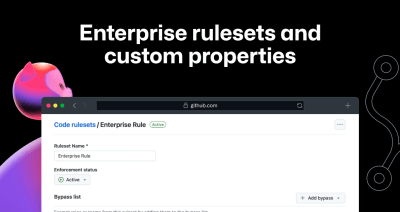
Git turns 20: A Q&A with Linus Torvalds
To celebrate two decades of Git, we sat down with Linus Torvalds—the creator of Git and Linux—to discuss how it forever changed software development.

To celebrate two decades of Git, we sat down with Linus Torvalds—the creator of Git and Linux—to discuss how it forever changed software development.

What is CORS and how can a CORS misconfiguration lead to security issues? In this blog post, we’ll describe some common CORS issues as well as how you can find and fix them.

Following the ship of transitive labeling for npm packages, the same capabilities are now available for Maven packages: Dependabot alerts now contain a direct label if they are associated with…

Enterprise custom properties and enterprise rulesets are now generally available, further improving the governance features for GitHub Enterprise customers. Enterprise custom properties With enterprise-level custom properties, you can now enrich…

Critical authentication bypass vulnerabilities (CVE-2025-25291 + CVE-2025-25292) were discovered in ruby-saml up to version 1.17.0. In this blog post, we’ll shed light on how these vulnerabilities that rely on a parser differential were uncovered.

The refreshed commit details page is now generally available! This improved page lets you view and navigate the changes within a commit with improvements to filtering, commenting, and keyboard navigation.…

For 30 years, Java has been a cornerstone of enterprise software development. Here’s why—and how to learn Java.

Treating exposures as full and complete can help you respond more effectively to focus on what truly matters: securing systems, protecting sensitive data, and maintaining the trust of stakeholders.

January and February brought a number of improvements to GitHub Mobile, making it more powerful and flexible. We’re rolling out exciting new features designed to make coding and collaboration easier…

We released a collection of improvements to Artifact Attestations to make the verification of attestations easier and more consistent. Artifact Attestations let you create provenance signatures, which provide an unforgeable…

As previously announced, Enterprise Managed Users (EMUs) no longer have their emails automatically verified. This helps prevent any accidental data leaks by third party GitHub Apps and OAuth applications that…

A deep dive on the work that went into making the component that powers repository and pull request file trees.

Learn how specially crafted artifacts can be used to attack Maven repository managers. This post describes PoC exploits that can lead to pre-auth remote code execution and poisoning of the local artifacts in Sonatype Nexus and JFrog Artifactory.

This week’s Copilot Workspace updates are focused on improvements to navigation and file management. As ever, drop your feedback into this discussion. Simpler file tree navigation When folders don’t have…

Now in public preview, Linux arm64 hosted runners are available for free in public repositories. Following the release of arm64 larger hosted runners in June, this offering now extends to…

We’re open sourcing Annotated Logger, a Python package that helps make logs searchable with consistent metadata.

As part of our ongoing efforts to improve flexibility and control for managing the security manager role, we are retiring the security manager API and replacing it with the more…

As you may have seen in Discord a few weeks ago, Copilot Workspace is graduating! It is a very exciting time, and also a time of change. So before getting…

The Gaady Awards are like the Emmy Awards for the field of digital accessibility. And, just like the Emmys, the Gaadys are a reason to celebrate! On November 21, GitHub was honored to roll out the red carpet for the accessibility community at our San Francisco headquarters.

Artifact Attestations now supports attesting multiple subjects simultaneously. When the attest-build-provenance or attest-sbom actions create multiple attestations, a single attestation is created with references to each of the supplied subjects,…

To help you better understand the state of your pull request and get it merged faster, the merge experience on the pull request page has been improved! This experience is…
Build what’s next on GitHub, the place for anyone from anywhere to build anything.
Catch up on the GitHub podcast, a show dedicated to the topics, trends, stories and culture in and around the open source developer community on GitHub.